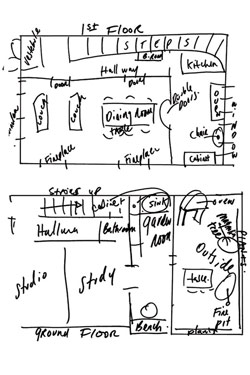
Photographs by Adrian Gaut
“We wanted a house that had not been touched,” says Brooklyn restaurateur Andrew Tarlow of the 1863 townhouse in Fort Greene that he and his wife, Kate Huling, purchased in 2007. “When we saw this house, it was like stepping back in time.”
Tarlow knows the whole story: “The house was built by a seaman for his two unmarried nieces. They had no children and left it to their maid who lived here her whole life. She had no children and left it to her nephew, who sold it to a nun and priest who lived here for more than 40 years.”

Huling says the couple house-hunted for seven years before finding this one. “Most of the houses we saw had been done poorly,” she says. “This house was untouched and perfectly pristine.”
Because of that, the couple, who have four children (Elijah, 12, Beatrice, 7, Roman, 4, and Paloma, 1), have done very little to the six-bedroom home. They repainted the ceiling in the living room so it looks distressed, relined the fireplace, remodeled the kitchen and back garden where they added a fireplace for cooking, and redid the second-floor bathroom.
So instead of embarking on pricey, years-long renovations, Tarlow and Huling embraced what they had and settled in. “The parlor floor is 100 percent the center of operations,” says Huling. “It’s where Elijah and Bea do their homework, Roman and Paloma play, and we cook.” No toys are allowed on this level, and there are no televisions in the house. “At my house growing up, there was a television in every room,” says Tarlow. “But at some point, I started to live without it, and I’ve never gone back. The kids don’t know the difference. They don’t know about Saturday-morning cartoons. They read, play together, and draw.”
Their aesthetic is authentically unfussy and harkens back to a time when large families and home-cooked meals were the norm. Most of the furniture was found on the street, in a thrift store, or was built by Tarlow, who also has kept busy with his growing culinary empire—Diner, Marlow & Sons, Marlow & Daughters, Roman’s, Reynard at the Wythe Hotel (the hotel is his, too), and Achilles Heel.
Huling, meanwhile, designs leather goods and fashion separates, sold in Marlow & Sons, from the hides of the meat they serve. There are also blankets and throws of sheep’s wool from the farms they work with. “To live a life where we can work together and have our family so near, it’s totally dreamy,” says Huling.
But their home has a different feeling from their restaurants. As Huling puts it, “I am in love with Moroccan rugs and Andrew’s paintings, and you won’t find any of those things in the restaurants,” she says. “Our house is more a collection of hand-me-downs and souvenirs from travel.”

When Tarlow and his family moved in, the kitchen was covered in aqua wallpaper. They soon discovered a colony of water bugs beneath it, so down it came. The plaster walls underneath were painted and tiles and shelving were added. The shelves were built by a friend. “We cook big family dinners every night that we’re not eating at one of the restaurants. We are well fed to say the least,” says Tarlow’s wife, Kate Huling. “We bought a slop sink from Home Depot, and our kitchen-supply guy gave us a free stove from his warehouse,” says Huling. Photo: Adrian Gaut

This calendar was made by a friend who owns a letterpress in Crown Heights. You can find them for sale at Marlow & Sons every December. Photo: Adrian Gaut

This sitting area is outside the master bedroom (it’s actually atop the kitchen’s roof). The orange chairs are from Fermob. Photo: Adrian Gaut

Tarlow found the lamp, in the foreground, on the street. “It worked!” says Huling. The dog belongs to a friend. Photo: Adrian Gaut

The couple has placed Moroccan accents throughout the house, like this light by San Francisco”based Tazi Designs. Photo: Adrian Gaut

The dining-room table was made by Tarlow. The ceiling was inspired by Italian stucco ceilings. “Our original paint job was so shoddy that the paint quickly started to peel, revealing the ochre plaster underneath,” Huling says. “We decided to go with it.” The chandelier was a hand-me-down from Tarlow’s mother. Photo: Adrian Gaut

This was Tarlow’s mother’s couch, which the couple reupholstered in linen from Gray Lines Linen in the garment district. “We don’t buy new furniture,” Huling says. “There is enough furniture out there in the world to repurpose and re-inspire.” Tarlow was a painter before opening his restaurants and the Wythe Hotel. His art is hung all around the house. This chandelier was also a gift from Tarlow’s mother; the pier glass came with the house. Photo: Adrian Gaut

In the mudroom on the garden level, cupboards contain gardening supplies, shoes, and an endless stream of mailings from the children’s schools. The wooden boxes are apple crates from Tarlow’s restaurants. Photo: Adrian Gaut

The bookshelf was found upstate. Photo: Adrian Gaut

The dining room is “Tarlow headquarters,” says Huling. The table can seat up to 25. The art above the fireplace is by Tarlow. Photo: Adrian Gaut

Beatrice, Roman, and Elijah hang out in the living room. When it comes to furniture, Huling’s motto is “nothing too precious.” Photo: Adrian Gaut

“The children sleep in our room until they’re 2 or 3 years old when they realize it’s much cooler to sleep upstairs with their siblings,” Huling says. “We don’t really push those things, and it always seems to work out best that way.” Photo: Adrian Gaut

